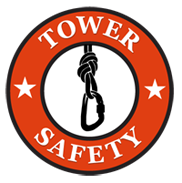Rigging with a Carabiner the ANSI 10.48
Rigging is a dynamic artform; assembling and securing ways to control and support a load is vital on any lift, whether it be a live person or a radio, antenna, tool bags, etc. However, the hardware we use for attachment to the load can vary from steel shackles, soft shackles, quick links, and carabiners! CARABINERS?? Yes, since the 1600’s this piece of equipment has helped boaters, utility workers, riggers, arborists, climbers, and many more around the world. The word ‘carabiner’ is shortened form of the German word ‘Karabinerhaken’ which translates directly to a “carabinier’s hook”. This was a type of closing hook used by soldiers to attach their carbine rifle to a strap and sling it around their shoulders. Six hundred years later, we are still attaching modern-day carabiners to slings and other anchor points.
The history of a carabiner leads us to one the most controversial and confusing topics in telecom rigging. In 2016, the ANSI 10.48 was released for best practice when lifting telecom equipment. The 10. 48 standard is a positive for ensuring rigging plans are created for each lift, understanding sling, block, and tag line angles. However, the standard does mention carabiners are okay to use if specifically classified by the manufacture for lifted loads, interpreting that verbiage; carabiners need to have ABS, MBS, WLL, or FS for use. Below is an example of a WLL carabiner by Buckingham Mfg. with a 3-Sigma rating, which means 99.9% of the products are stronger than the reported MBS rating.
.
With the ANSI 10.48 allowing the use of carabiners, successful rigging requires an understanding of physics and Isaac Newton’s Law of Motion:
- An object will not change its motion unless a force acts on it.
- The force on an object is equal to its mass times its acceleration.
- When two objects interact, they apply forces to each other of equal magnitude and opposite direction.
One of the biggest myths we are taught from a young age is that our “weight” is measured in pounds or kilograms. While this is fine for most daily situations such as a letter, shipping box or standing on a scale, it is not so good for performing calculations once you start connecting loads. A “mass” such as an antenna or a live load will change on how we calculate, by mathematically using Newtons or kN, not pounds. WLL is measured in lbs., which can NOT be mathematically solved, when trying to calculate “Kinetic Energy”- Hidden Energy!
Kinetic Energy is calculated in kN and the type of hardware we should be connecting to our loads has to address shock loading. Another way to look at it; weight describes the force “of” a mass being influenced by gravity, it creates the “load/weight” sitting on a surface and measured in pounds and it “should be” should be converted into Newtons (N) or 1 pound force/4.44822N = a measurement of force. Equipment manufacturers use 3-sigma testing to get the rating for a carabiner that is expected to support a Load/Mass by performing tests that pull them to failure. The manufacturer uses kN to reflect the testing criteria and stamp information on the carabiner such as WLL, kN, FS for axial loading, tri loading or possible, cross loading of carabiners. It’s all about the Newtons from here my friends.
- Newtons to a “kN” = 0.001
- 10 Newtons converted to kN = 0.01 (divide the force value by 1000)
- 1 Kilogram = 2.2 lbs.
For example, the weight of an antenna is 100kg (220 lbs.), this weight applies to the surface and is a result of the gravitational pull towards the center of our earth. We quantify this force by multiplying the mass (100kg) by the acceleration it would experience towards the center of the Earth if our surface was not present. This rate of acceleration is assumed to be 9.81 meters per second, or 9.81ms squared.
Force = Mass x Acceleration or F = ma.
So Weight = Mass x Acceleration due to gravity, or W = mg.
lbs. kg
weight / mass
-
- Pounds (lbs.) is a measure of weight, and weight is just force
- Mass is a object determined by volume & density / Weight is an object defined by the force of gravity. Weight is a force and measured in the newton
- N- Newtons, the units of force
Once we understand a little physics, we know there is more to lifting than just the weight of a load.
Definitions:
What is a Load?
1: Something lifted and carried
- A mass or weight supported by something
What is a WLL (Working Load Limit)?
- Shows the maximum load equipment in normal use can be exposed too and does not include a factor of safety
- Not designed for live loads
What is a FS (Factor of Safety)?
- Actual Load-Bearing capacity of a structure or component
- The required margin of safety for a structure or component according to code, law or design
What is a Static Load?
- Static loads are lifts where the forces are constant
What is a Dynamic Load?
- Dynamic loads are created by lifts in motion of variable forces. The 10.48 mentions the use of a load cell, but it should be used to measure forces generated at peak loads.
Rigging is a skilled craft of being able to creatively lift – if you do NOT have a foundation, you cannot rig well, and you absolutely should NOT be Creative in your rigging unless you are a seasoned rigger. Rigging involves block & tackle, progress captures, progress hauls, mechanical advantages and understanding the forces put on the entire rigging system, including the anchor(s).
After all that, do we know proper sling usage with a shackle or a carabiner? Stay tuned…
Tower Safety covers all these topics in the RRAT (Rope & Rigging Access Technician) class with an eye to helping those with the need to see the whole picture of rigging.
You want to be at the top of your career by knowing what you don’t know, come see us at Tower Safety, you will come away with another level of knowledge and experience you did not know existed.
Tower Safety Training










